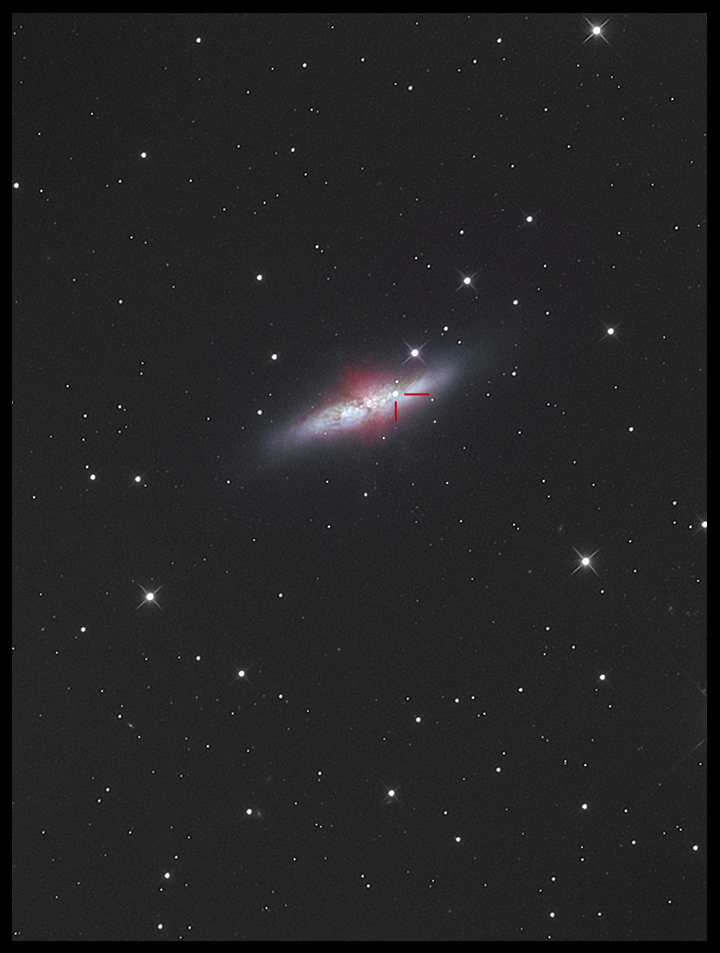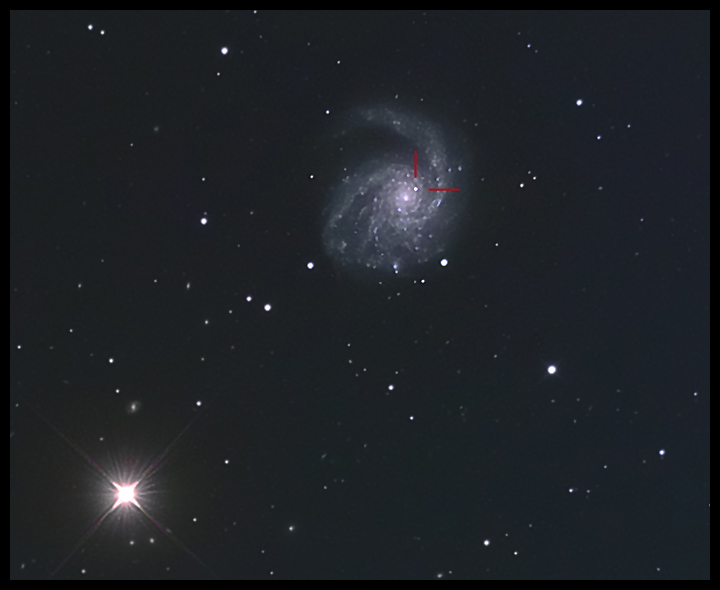1/31/2014. I grouse a lot about how rarely I can stargaze here in the cloudy, tree-covered, light-polluted east, so when I do get a run of clear, moonless skies I feel as though I can't waste an hour. It's a kind of sleep disorder. The skies are very clear and reasonably steady tonight, so in the evening, I took better color for the NGC 660 field imaged last November. It's coming along, but I'm still not happy with the finished result. Then I shot new darks and fresh flats. When they finished (around midnight) I once again checked out SN 2014J in M82 which should be near maximum light. Finally, I started taking luminance data from the supernova in M99 which was named SN 2014L earlier today. I wasn't quite finished, because I suffered a shower epiphany about the way I've been processing my images.
Here's the best I've got of two current supernovae, all the best data put in one big pile and refined.

SN 2014J in M82
Best 16 out of 24x150s L (45 min)
6x150s GB (30 min total)
2x1800s Ha (1 hr)

SN 2014L in M99
32x300s, 42x150s L (4hr 25m), 9x150s RGB (1hr 7m 30s total)
Cropped.
I have SN2014J at magnitude 10.60 based on the AAVSO's 10.6 magnitude field star. And I have SN 2014L at magnitude 15.3 +/- .1 based on Guide's magnitude of 11.9 for a nearby field star (the result is uncertain because the supernova and the nucleus of M99 make a crowded field at my plate scale). For photometry I only used last night's luminance data.
The shower epiphany: I've been habitually deconvolving in PixInsight using very large PSFs(*) similar to those that I fine-tuned for solar work using a 90mm refractor under turbulent daytime skies and a video camera with tiny pixels. Every one of those factors produces larger ideal and actual PSFs than are appropriate for a 10-inch R-C under steadier night-time skies feeding the larger pixels of the CCD camera.
When I took up last night's M99 data this morning, I rejected several cloud- or treetop-damaged frames. Even so, a stack of the remaining images produced out of round stars. So I had Maxim reject all images with PSFs larger than 5 seconds of arc and elongations greater than 10%. For both M82 and M99, Maxim rejected about 20% of the available images. Much cleaner processed images resulted. Then I tried 7x7 arrays in PixInsight's deconvolution subroutines rather than the 15x15 arrays that typify those used to sharpen my solar videos. I see great improvement. I routinly applied a 3x3 median filter in Maxim to remove the last hot pixels (a few not removed by dark subtraction) before beginning the deconvolution process, then 10 passes of regularized Richardson-Lucy deconvolution at 11x11 to recover most of the median blur, then 10 passes at 7x7, then mask the stars, and apply 10 passes of 7x7 RRL repeatedly (to the point of diminishing returns) then back out the last set of RRL decon. And voila, you have what you see here. Nothin' to it, eh?
* PSF = Point Spread Function, a representation of the way a point source of light is smeared across the detector. If you know the PSF of a system, you can derive an approximation of its inverse to "unsmear" the light into a sharper image. That's what the deconvolution software attempts to do. The most famous example was the software used to save Hubble imagery before corrective optics could be designed, launched, and installed; the same algorithms can improve poor focus, bad seeing, and less than perfect tracking -- up to a point. Deconvolution will also help defeat optical diffraction and assorted optical flaws. It's not a free lunch, but computer cycles are cheap.
Except where noted, deep-sky photos are made with an SBIG ST2000XM CCD behind a 10-inch Astro-Tech Ritchey-Chretien carried on an Astro-Physics Mach1GTO. The CCD is equipped with Baader LRGB and 7nm H-a filters. The internal guide chip of the CCD most often keeps the OTA pointed in the right direction (I'll let you know when a Meade DSI and a separate OAG or guidescope takes its place). Camera control and guiding are handled by Maxim DL 5.12. The stock focuser on the AT10RC has been augmented with Robofocus 3.0.9 using adapters turned on the lathe downstairs. Maxim performs image calibration, alignment, and stacking; Photoshop CS4 and FocusMagic 3.0.2 take it from there. Gradient Xterminator by Russell Croman and Astronomy Tools by Noel Carboni see their share of work, too. Beginning in May 2013, PixInsight has taken over some of the heavy lifting for transfer function modification and deconvolution.
:: top ::